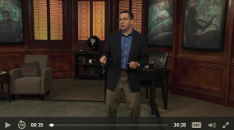Kevin Flanigan teaches vocabulary in this series of 36 video lectures, each of which runs about 30 minutes. The course should be great for teens and adults.
Flanigan teaches five key principles for learning vocabulary:
- Learn a clear definition
- Place the word in context–how does it sound in a sentence?
- Make connections to the word–think of familiar instances in which you might use the word
- Look at the word’s morphology–look into the word’s root or explore related words
- Organize words into categories or relationships, what he calls semantic chunking
The last principle is so important that Flanigan uses it to teach the vocabulary words in this course, grouping together words that are associated in some fashion.
The course draws heavily upon Greek and Latin roots since they underlie a large majority of words in the English language. For example Lecture 7, titled “Wicked Words,” teaches words that share the Latin root malus which means bad, badly, or evil. Among words studied are malediction, malcontent, malaise, maladroit, malefactor, malfeasance, and malinger. Along the way, students learn the word malfunction as a key word that can help them unlock the meanings of other words. They also learn the word benediction as an antonym to malediction as well as other bonus words that share the mal- prefix: malignant, malevolent, malice, and malware. In each lesson, words do not always share the same root, but they will be related to one another in some way to make it easier to learn them.
Flanigan’s goal is to help students expand their usable vocabulary. To that end, he explains the relationships between the words, their etymologies, and other fascinating information that helps students become familiar with them.
Here is an example from Lecture 12, “Humble Words and Prideful Words.” One of the words he introduces is bombast. He first explains its 16th century origin when bombast was used to describe cotton padding, cheap material that was used to stuff cushions or pillows. He then explains the modern-day meaning: “words that are used to fill empty speeches or writing to make up for a lack of substance” (p. 78). He next discusses the adjectival form of bombast which is bombastic. Since the word is most commonly used in its adjectival form, he provides a number of synonyms for bombastic: turgid, orotund, verbose, prolix, florid, flowery, and pretentious. At least a few of these synonyms are likely to be unfamiliar to students, so Flanigan provides a brief explanation of each of these words. For example, this is what he has to say about orotund: “Orotund comes from the Latin phrase ore rotundo, meaning “with rounded mouth,” and somewhat paradoxically, has either a positive or a negative connotation, depending on how it’s used. Orotund can be positive when referring to a resonant, booming voice and negative when referring to bombastic speech or writing” (p.78).
Perhaps this seems like following rabbit trails, but I think most students will find it an interesting way to learn vocabulary.
The 291-page guidebook for this course reads fairly close to the script as Flanigan presents it, although there are minor differences. In the guidebook there are from four to eleven review questions at the end of each lesson. Answers are at the back of the book along with a glossary of the words taught in the course and a bibliography.
Flanigan encourages students to create a vocabulary notebook whether handwritten or on a computer. He explains how to arrange the notebook in the second lecture. Students will write out words, definitions, and other pertinent information in their notebook. They might also draw graphic organizers or illustrations as memory devices.
I have only one complaint about this course. Flanigan moves up and down oddly while he lectures--enough that I find his movements distracting. While this is annoying, it is not a major issue.
Overall, this course is really outstanding. The principles Flanigan teaches are excellent. While we could apply these principles on our own, the research required would be a lot of work. So I appreciate that Flanigan has done the research for us. His lectures make the course both fascinating and extremely helpful for building a stronger vocabulary. Some students might like this approach to vocabulary so much that they will investigate words on their own.









